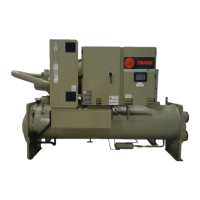70
RTHD-SVX01L-EN
Oil Sump Level Check
Running the chiller at minimum load is the best for the
quickest return of oil to the separator and sump. The
machine still needs to sit for approximately 30 minutes
before the level is taken. At minimum load, the discharge
superheat should be highest. The more heat in the oil as it
lays in the sump, the more refrigerant will boil off in the
sump and leave more concentrated oil.
The oil level in the oil sump can be measured to give an
indication of the system oil charge. Follow the procedures
below to measure the level.
1. Run the unit fully unloaded for approximately 20
minutes.
2. Cycle the compressor off line.
NOTICE
Equipment Damage!
Operating compressors with service valves open will
result in severe oil loss and equipment damage.
Never operate the compressor with the sight glass
service valves opened. Close the valves after
checking the oil level.
Figure 40. Determining oil level in sump
3. Attach standard refrigeration hose with a sight tube in
the middle to the oil sump drain valve and the
condenser service valve at the top of the condenser.
Using high pressure rated clear hose with appropriate
fittings can help speed up the process.
Note: A shutoff valve at one end of the hose is
recommended to facilitate hose drainage after oil
level check is completed.
4. After the unit is off line for 30 minutes, move the
sightglass along the side of the oil sump.
5. The level should be between 2 inch and 5 inch from the
bottom of the oil sump.
Note: If oil levels are not between 2 inch and 5 inch,
contact Trane service.
Optional AFD Periodic Maintenance and
Inspection
AFD periodic maintenance and inspections should be
performed every 1–12 months, depending on operating
environment.
Visual Inspection — Power Removed
WARNING
Hazardous Voltage w/Capacitors!
Failure to disconnect power and discharge capacitors
before servicing could result in death or serious
injury.
Disconnect all electric power, including remote
disconnects and discharge all motor start/run
capacitors before servicing. Follow proper lockout/
tagout procedures to ensure the power cannot be
inadvertently energized. For variable frequency drives
or other energy storing components provided by
Trane or others, refer to the appropriate
manufacturer’s literature for allowable waiting periods
for discharge of capacitors. Verify with a CAT III or IV
voltmeter rated per NFPA 70E that all capacitors have
discharged.
1. Ensure the door interlocks are present and working.
2. Verify the safety ground connections to the door panels
are securely connected.
3. Inspect power wire cables and devices to assure no
abrasion is occurring from vibrations against chassis of
cabinets, or other edges.
4. Ensure the drive interior and exterior is clear of any
dust or debris. Fans, circuit boards, vents etc. must be
clean.
Important: Only use a vacuum for cleaning. DO NOT
use compressed air.
5. Inspect the interior of the drive for any signs of moisture
entry or leakage.
6. Visually inspect all drive components and wiring. Look
for signs of heat or failure (look for swelled or leaking
capacitors, discolored reactors or inductors, broken
pre-charge resistors, smoke or arc trails on MOVs and
capacitors, etc.).
7. Closely inspect the motor terminal board for any signs
of leakage, arcing, etc.
8. Check ALL cable/lug/terminal connections inside the
drive enclosure. Ensure all are clean and tight, and not
rubbing against each other anywhere.
Maintenance

